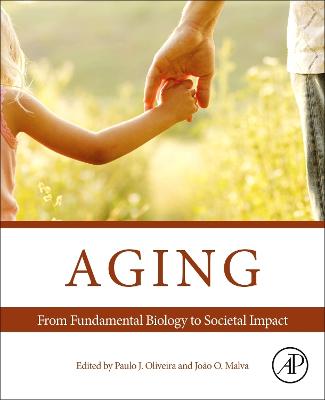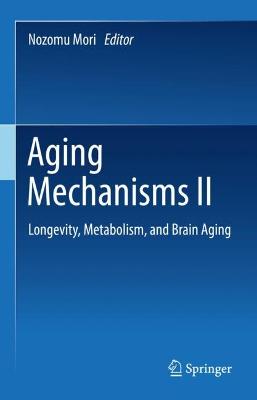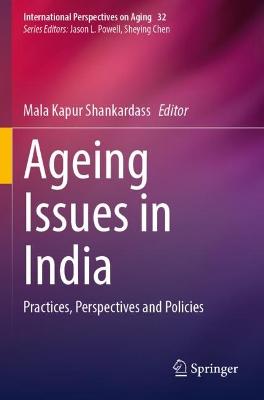Aging
 portes grátis
portes grátis
Aging
From Fundamental Biology to Societal Impact
Malva, Joao O.; Oliveira, Paulo J.
Elsevier Science Publishing Co Inc
09/2022
820
Mole
Inglês
9780128237618
15 a 20 dias
Descrição não disponível.
Section 1. The Societal Burden of Aging
1. Aging at a global level
2. The financial and economical burden of aging worldwide
3. Flagship initiatives for healthy living and active aging in Europe
4. Flagship initiatives for healthy living and active aging in Africa
5. Flagship initiatives for healthy living and active aging in North America
6. Flagship initiatives for healthy living and active aging in Asia and Oceania
7. Flagship initiatives for healthy living and active aging in Central and South America
Section 2. The Biology of Aging
8. A metabolic and mitochondrial angle on aging
9. Intracellular communication and aging
10. Genomic instability and telomere attrition
11. Cellular senescence during aging
12. The epigenetics of aging
13. Disrupted cellular quality control mechanisms in aging
14. Deregulated nutrient sensing in aging
15. Stem cells fitness and aging
16. Programming of early aging
Section 3. Aging-related physiology, disease and prevention of aging-related diseases
17. Adherence to therapy and polymedication
18. Frailty and cognitive decline
19. Cardiovascular aging
20. Aging-related neoplasia
21. Inflammation
22. Geroscience: An unifying view on aging as a risk factor
23. Building healthy aging
Section 4: The Future and Innovation in Aging
24. The future of innovation in aging
25. Machine learning in the context of better healthcare in aging
26. The knowledge and research in aging for the future
27. The future of integrated care in aged individuals
28. Moving from reactive to preventive medicine
29. Personalized medicine: will this work for decreasing aging-related morbidities
30. Anti-aging interventions: myths and realities
1. Aging at a global level
2. The financial and economical burden of aging worldwide
3. Flagship initiatives for healthy living and active aging in Europe
4. Flagship initiatives for healthy living and active aging in Africa
5. Flagship initiatives for healthy living and active aging in North America
6. Flagship initiatives for healthy living and active aging in Asia and Oceania
7. Flagship initiatives for healthy living and active aging in Central and South America
Section 2. The Biology of Aging
8. A metabolic and mitochondrial angle on aging
9. Intracellular communication and aging
10. Genomic instability and telomere attrition
11. Cellular senescence during aging
12. The epigenetics of aging
13. Disrupted cellular quality control mechanisms in aging
14. Deregulated nutrient sensing in aging
15. Stem cells fitness and aging
16. Programming of early aging
Section 3. Aging-related physiology, disease and prevention of aging-related diseases
17. Adherence to therapy and polymedication
18. Frailty and cognitive decline
19. Cardiovascular aging
20. Aging-related neoplasia
21. Inflammation
22. Geroscience: An unifying view on aging as a risk factor
23. Building healthy aging
Section 4: The Future and Innovation in Aging
24. The future of innovation in aging
25. Machine learning in the context of better healthcare in aging
26. The knowledge and research in aging for the future
27. The future of integrated care in aged individuals
28. Moving from reactive to preventive medicine
29. Personalized medicine: will this work for decreasing aging-related morbidities
30. Anti-aging interventions: myths and realities
Este título pertence ao(s) assunto(s) indicados(s). Para ver outros títulos clique no assunto desejado.
?Active aging; Adverse events; Ageing; Aging; Aging elderly Cabo Verde; Aging gender Cabo Verde; Aging population; Aging poverty Cabo Verde; Apoptosis; Asia and Oceania; Autophagy; Barker hypothesis; Behavior; Biological aging; Biology; Biomarkers; Birth rates; COVID-19; COVID-19 pandemic; Cancer; Cancer incidence; Carcinogenesis; Cardiac pathologies; Cardiovascular disease; Cardiovascular diseases; Cell aging; Cellular senescence; Centenarians; Chromatin remodeling; Chronic disease; Chronic diseases; Chronological age; Comics; Control and prevention; Coronary heart disease; DNA damage; DNA damage response; DNA methylation; DNA repair; Dementia; Determining factors; Diabetes; Digital solution; Early aging; Elderly; Epidemiological changes; Epigenetic clocks; Epigenetics; Fibroblasts; Flagship; Frail; Frailty; Gap Junctions; Genetic profile Cabo Verde; Genomic instability; Genomics; Geography climate Cabo Verde; Geriatric; Geroscience; Good practices; Hallmarks of aging; Health; Health numeracy; Health span; Health systems; Healthy aging; Healthy living; Healthy survival; Heart failure; Histone acetylation; Histone methylation; Homeostasis; Human disease; Immunosenescence; Inflammaging; Innovation; Integrated care; Intercellular Communication; Intervention; Interventions; Lifespan; Longevity; Low birth weight; MTOR; Machine learning; Medication management; Medication nonadherence; Mesenchymal stem cells; Metabolomics; MiRNA; Microbiome; Mitochondria; Mitochondrial dysfunction; Mitogenic signals; Models in aging; Molecular imaging; Morbidity compression; Multimorbidity; National Health Service Cabo Verde; Natural selection
Section 1. The Societal Burden of Aging
1. Aging at a global level
2. The financial and economical burden of aging worldwide
3. Flagship initiatives for healthy living and active aging in Europe
4. Flagship initiatives for healthy living and active aging in Africa
5. Flagship initiatives for healthy living and active aging in North America
6. Flagship initiatives for healthy living and active aging in Asia and Oceania
7. Flagship initiatives for healthy living and active aging in Central and South America
Section 2. The Biology of Aging
8. A metabolic and mitochondrial angle on aging
9. Intracellular communication and aging
10. Genomic instability and telomere attrition
11. Cellular senescence during aging
12. The epigenetics of aging
13. Disrupted cellular quality control mechanisms in aging
14. Deregulated nutrient sensing in aging
15. Stem cells fitness and aging
16. Programming of early aging
Section 3. Aging-related physiology, disease and prevention of aging-related diseases
17. Adherence to therapy and polymedication
18. Frailty and cognitive decline
19. Cardiovascular aging
20. Aging-related neoplasia
21. Inflammation
22. Geroscience: An unifying view on aging as a risk factor
23. Building healthy aging
Section 4: The Future and Innovation in Aging
24. The future of innovation in aging
25. Machine learning in the context of better healthcare in aging
26. The knowledge and research in aging for the future
27. The future of integrated care in aged individuals
28. Moving from reactive to preventive medicine
29. Personalized medicine: will this work for decreasing aging-related morbidities
30. Anti-aging interventions: myths and realities
1. Aging at a global level
2. The financial and economical burden of aging worldwide
3. Flagship initiatives for healthy living and active aging in Europe
4. Flagship initiatives for healthy living and active aging in Africa
5. Flagship initiatives for healthy living and active aging in North America
6. Flagship initiatives for healthy living and active aging in Asia and Oceania
7. Flagship initiatives for healthy living and active aging in Central and South America
Section 2. The Biology of Aging
8. A metabolic and mitochondrial angle on aging
9. Intracellular communication and aging
10. Genomic instability and telomere attrition
11. Cellular senescence during aging
12. The epigenetics of aging
13. Disrupted cellular quality control mechanisms in aging
14. Deregulated nutrient sensing in aging
15. Stem cells fitness and aging
16. Programming of early aging
Section 3. Aging-related physiology, disease and prevention of aging-related diseases
17. Adherence to therapy and polymedication
18. Frailty and cognitive decline
19. Cardiovascular aging
20. Aging-related neoplasia
21. Inflammation
22. Geroscience: An unifying view on aging as a risk factor
23. Building healthy aging
Section 4: The Future and Innovation in Aging
24. The future of innovation in aging
25. Machine learning in the context of better healthcare in aging
26. The knowledge and research in aging for the future
27. The future of integrated care in aged individuals
28. Moving from reactive to preventive medicine
29. Personalized medicine: will this work for decreasing aging-related morbidities
30. Anti-aging interventions: myths and realities
Este título pertence ao(s) assunto(s) indicados(s). Para ver outros títulos clique no assunto desejado.
?Active aging; Adverse events; Ageing; Aging; Aging elderly Cabo Verde; Aging gender Cabo Verde; Aging population; Aging poverty Cabo Verde; Apoptosis; Asia and Oceania; Autophagy; Barker hypothesis; Behavior; Biological aging; Biology; Biomarkers; Birth rates; COVID-19; COVID-19 pandemic; Cancer; Cancer incidence; Carcinogenesis; Cardiac pathologies; Cardiovascular disease; Cardiovascular diseases; Cell aging; Cellular senescence; Centenarians; Chromatin remodeling; Chronic disease; Chronic diseases; Chronological age; Comics; Control and prevention; Coronary heart disease; DNA damage; DNA damage response; DNA methylation; DNA repair; Dementia; Determining factors; Diabetes; Digital solution; Early aging; Elderly; Epidemiological changes; Epigenetic clocks; Epigenetics; Fibroblasts; Flagship; Frail; Frailty; Gap Junctions; Genetic profile Cabo Verde; Genomic instability; Genomics; Geography climate Cabo Verde; Geriatric; Geroscience; Good practices; Hallmarks of aging; Health; Health numeracy; Health span; Health systems; Healthy aging; Healthy living; Healthy survival; Heart failure; Histone acetylation; Histone methylation; Homeostasis; Human disease; Immunosenescence; Inflammaging; Innovation; Integrated care; Intercellular Communication; Intervention; Interventions; Lifespan; Longevity; Low birth weight; MTOR; Machine learning; Medication management; Medication nonadherence; Mesenchymal stem cells; Metabolomics; MiRNA; Microbiome; Mitochondria; Mitochondrial dysfunction; Mitogenic signals; Models in aging; Molecular imaging; Morbidity compression; Multimorbidity; National Health Service Cabo Verde; Natural selection







